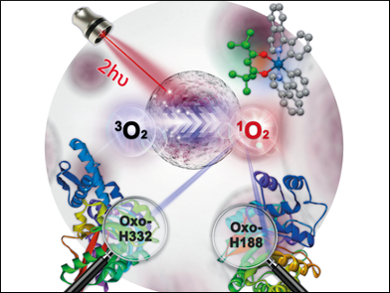Photochemotherapy is attractive and offers the prospect of localized attacks on cancer cells, whilst sparing normal tissue. It can generate highly reactive chemical species, which bypass cell-resistance mechanisms.
Peter B. O’Connor, Peter J. Sadler, University of Warwick, Coventry, UK, Hui Chao, Sun Yat-Sen University, Guangzhou, China, and colleagues have designed photoactive metal coordination complexes with optimized properties for such therapies. The researchers synthesized octahedral organoiridium(III) complexes, which are highly stable in the dark. Time-dependent density functional theory (TD-DFT) calculations showed how the choice of chelating ligands controls light absorption.
The complexes’ excited states are long-lived and emit red light when irradiated with blue light. They generate highly reactive singlet oxygen from ground-state triplet oxygen efficiently. For this process, not only blue light can be used, but also red light (which penetrates more deeply into tissues), as short two-photon laser pulses.
The team demonstrated the high selective potency of these photoactivated iridium complexes toward lung cancer compared to normal lung cells, including 3D spheroid models of tumors. The induction of oxidation of specific histidine residues in the key cellular proteins aldose reductase and heat shock protein 70 in cancer cells was detected using ultra-high resolution mass spectrometry.
- Organoiridium Photosensitizers Induce Specific Oxidative Attack on Proteins within Cancer Cells,
Pingyu Zhang, Cookson K. C. Chiu, Huaiyi Huang, Yuko P. Y. Lam, Abraha Habtemariam, Thomas Malcomson, Martin J. Paterson, Guy J. Clarkson, Peter B. O’Connor, Hui Chao, Peter J. Sadler,
Angew. Chem. Int. Ed. 2017.
DOI: 10.1002/anie.201709082




